Last of two parts
HAMPSTEAD — Vic French steps across a meadow of wire grass and gall berry at the Holly Shelter Game Lands Preserve to draw a distinction between the tidy, longleaf woodland and the adjacent jumble of a Carolina bay community.
Supporter Spotlight
Pond pines and loblolly bays jut above the dense, impenetrable understory of red and sweet bay, wax myrtle and unending twists of greenbrier.
Unlike the sandy longleaf pine woodland floor, soils here are deep and rich in organic matter – the by-product of undisturbed cycles of decomposing plant material – as much as six feet deep. The densely intertwined vegetation provides perfect cover for all manner of wildlife, including black bear, wild turkey, nesting birds and reptiles, such as frogs and turtles.
Unfortunately, this preferred habitat proved fatal for wildlife caught in the lightning-sparked wildfire during the summer of 2011. The fire, which began in June, smoldered relentlessly in mostly inaccessible areas where drought had turned deep organic soils to tinder. By the time Hurricane Irene extinguished the embers in August, more than 30,000 acres were reduced to ash.
“Pond pines are not fire resistant. They fell over and burned, along with the dry understory. The fire was so intense, the soils burned away. The ground level dropped significantly and the seed banks and roots were destroyed,” says French, a biologist with the N.C. Wildlife Resources Commission. “It all will be under water when the heavy rains come.”
Recovery From Fire
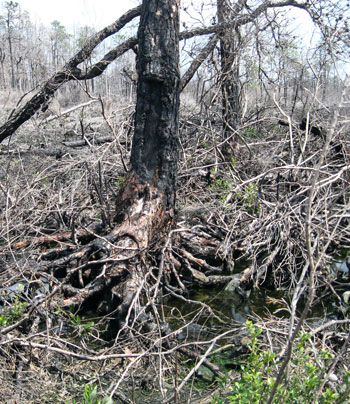 Supporter SpotlightThe fire last year burned deep into the peat soil. Photo: Pam Smith |
Recovery in the vast devastated area seems doubtful any time soon.
The drought that caused a drop in the water table also dried up creeks and streams that might have helped lessen the path of destruction. Fire-fighting became a matter of containment efforts, French explains. To box the fire in, wide corridors were cleared of vegetation along existing roads and power grids, exposing bare soil and removing burnable material, in order to break the fire’s spread.
Another fire that started last weekend outside the preserve threatened to cross over into the game lands.
Oddly, protected plants such as the Venus fly trap and sun dew are showing up in random spots and pitcher plants are making a comeback along disturbed areas at the fringes of the fire zone.
The rare carnivorous plants commonly grow in Holly Shelter savannas – the transition zones between dry longleaf woodlands and wet pocosin habitat.
Don’t ask French to name his favorite part of Holly Shelter. It’s a bit like asking a father to choose his favorite child. “It changes with every season,” he says.
Case in point: As French pulls his pick-up truck alongside the Ashes Creek impoundment, the crunch of tires on the gravel road results in a flurry of activity nearby. Nearly 500 green-winged teal ducks frantically rise from the water, circle the marsh, and settle onto a more secluded spot to renew grazing the smorgasbord of grasses and insects in the shallow fresh water.
“They showed up a couple of weeks ago,” French notes with an edge of excitement in his voice. “I’ll show you another recent arrival.”
He drives a couple hundred yards and points across an open field to the edge of a burned out Carolina bay community. A newly built eagle’s nest sits at the top of a singed, skeleton of a tree.
“It’s a mystery why the eagle chose that nearly dead tree,” French muses.
Nor can he account for the pair of wild turkeys that scurry along one of the plowed over fire break lines – not their usual preferred habitat.
A Good Place for Frogs
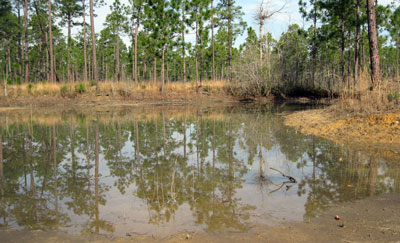 This pond is perfect breeding habitat for the rare Carolina gopher frog. Photo: Pam Smith |
Still, he knows for certain why rare Carolina gopher frogs choose to do their spring courting in bog ponds – some natural and some provided by wildlife personnel.
“We help Mother Nature out a bit by providing a clear pond with no fish to eat eggs or tadpoles during breeding season,” French says.
The good news is that most of the Holly Shelter Game Land was unscathed by last year’s fire. It continues to be a popular destination to observe the array of native plants, butterflies and beneficial insects that inhabit its diverse ecosystems.
Holly Shelter also is a birder’s delight: Along with the celebrated red-cockaded woodpecker, it is the year-round home to the Bachman’s sparrow; and, the preferred breeding habitat for the Acadian flycatcher, as well as Prothonotary, Swainson’s, hooded and yellow- throated warblers.
Many backyard gardeners are considering native plants in their landscapes because they are suited for the local climate and soils; are aesthetically pleasing; control invasive species; and provide habitat for a host of birds. If you’re one of them consider attending he N.C. Coastal Federation’s Native Plant Festival, April 27-28, at the group’s main office in Ocean in Carteret County.
Typical native plants that thrive in coastal counties include sweet bay magnolia, loblolly bay, bay laurel, sweet bay, gall berry, titi, fetterbush, zenobia and a variety of ornamental grasses.
|
|
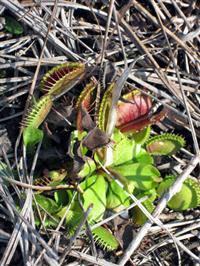 |
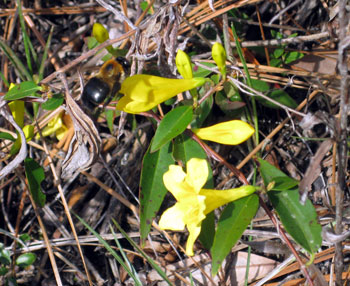 |
What You Should Know
Providing public hunting opportunities has been a major focus of the N.C. Wildlife Commission for decades.
Holly Shelter Game Lands’ origins can be traced to 1939 with the reallocation of 38,000 acres of untamed land from the N.C. Board of Education to the N.C. Conservation and Development Division – the forerunner of the N.C. Wildlife Resources Commission.
Since its creation as the Holly Shelter Wildlife Refuge, as it was known, the site has been expanded as a result of continued acquisitions and cooperative agreements with other state, federal, corporate and private landowners. The Federal Pittman-Roberson Act of 1937 enables ten percent tax on ammunition and firearms sales to go toward acquisition and preservation of wildlife restoration sites for hunting and fishing.
Much of the site is remote and inaccessible. A series of roads are open to the public for seasonal hunting in designated areas. Licensed hunters may arrange to stay at a primitive campsite for their quest of deer, squirrel, quail, wild turkey and black bear. And, handicapped sportsmen may use four-wheel recreational vehicles at two accessible game lands’ sites.
Two access points into Holly Shelter offer hikers and birders a chance to enjoy some of the game land’s diverse habitats.
Take N.C. 210 east from I-40 and cross the Northeast Cape Fear River. Drive less than a mile past the river and turn left on Shaw Highway (SR 1520). Go 7.3 miles to the Wildlife Commission boat access area by the river. Follow the trail along the dike between the river and the swamp forest.
From the intersection on N.C. 210 and U.S. 17 in Hampstead, drive north on U.S. 17 4.4 miles. Look for a N.C. Wildlife Commission sign on the left at the entrance to Lodge Road. The road is gated and closed from March 1 through Aug. 31, but you can walk into the game land here and walk through the flatwoods.
For additional information about Holly Shelter Game Lands, go here.



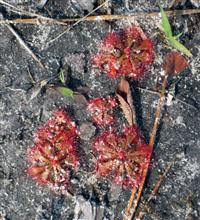 From left: sun dew, Venus fly trap and Confederate jasmine. Photos: Pam Smith
From left: sun dew, Venus fly trap and Confederate jasmine. Photos: Pam Smith



